#Punjab lyrics translation
Explore tagged Tumblr posts
Text
The Unstoppable Forces Behind South Asian Music Excellence
South Asia's music industry is a vibrant world filled with diverse genres, exceptional talent, and groundbreaking innovations. It has given rise to some of the most iconic names who continue to inspire generations of music enthusiasts. In this article, we delve deeper into the journeys of five extraordinary artists—each a trailblazer in their own right—and explore how they have transformed the soundscape of their respective domains.
South Indian Rhythms Elevated: Hiphop Tamizha
Hiphop Tamizha is synonymous with the evolution of Tamil hip-hop music. The duo, comprising Adhi and Jeeva, introduced a groundbreaking fusion of Tamil lyrics with Western hip-hop beats. With their debut album Hip Hop Tamizhan, they captured the imagination of a generation eager for something modern yet deeply rooted in tradition. Songs like “Club le Mabbu le” and their film compositions for hits like Meesaya Murukku showcased their knack for storytelling through music. Hiphop Tamizha's commitment to innovation has positioned them as cultural icons who bridge Tamil heritage with global music trends.
A Cultural Conduit: Arjun
When it comes to breaking cultural boundaries, few artists can compare to Arjun. Hailing from the UK with Sri Lankan heritage, Arjun has successfully blended Western pop and R&B with South Asian rhythms. His breakout hit, “Why This Kolaveri Di (R&B Remix),” put him on the global map and highlighted his ability to reimagine popular tracks with a fresh perspective. Arjun’s original compositions, such as “Take It Back” and “I’ll Be Waiting,” resonate with fans across continents. Through his multilingual approach, he has brought South Asian music closer to global audiences, creating a space for cultural appreciation and unity.
The Voice of Punjab: Gurlez Akhtar
In the world of Punjabi music, Gurlez Akhtar reigns supreme as a powerhouse vocalist. Known for her dynamic voice and remarkable range, Gurlez has collaborated with some of the biggest names in the Punjabi industry. Tracks like “Defaulter” and “Majha Block” highlight her ability to infuse raw energy into any composition, making her a fan favorite for high-energy bhangra tracks. Beyond her energetic performances, Gurlez’s versatility shines in emotional ballads that touch hearts. Her dedication and hard work have not only elevated her status as an artist but also empowered many aspiring female vocalists in a male-dominated industry.
Bollywood’s Masters of Melody: Sajid-Wajid
The late Wajid Khan and his brother Sajid Khan, collectively known as Sajid-Wajid, left an unforgettable legacy in Bollywood. With chartbusters like “Hud Hud Dabangg” and “Mashallah,” they redefined Bollywood music with their unique style that effortlessly blended traditional elements with contemporary beats. The duo’s strong bond translated into seamless collaboration, creating music that resonated with diverse audiences. From soulful tracks to electrifying dance numbers, Sajid-Wajid’s repertoire is a testament to their versatility and ability to adapt to evolving musical trends while staying true to their roots.
A Maestro of Emotion: Anand Raj Anand
Anand Raj Anand has long been a name synonymous with Bollywood's golden era of melody. His ability to craft songs that evoke deep emotions has made him one of the most celebrated music composers and singers in the industry. From the romantic ballad “Dil De Diya Hai” to the peppy anthem “Gori Gori,” Anand’s compositions have struck a chord with millions. His knack for capturing human experiences through music has made him a household name, and his journey continues to inspire countless artists aspiring to make their mark in Bollywood.
The Unified Legacy
The contributions of these five icons are a testament to the rich tapestry of South Asian music. Each artist brings a unique voice and perspective, showcasing the boundless potential of the region’s musical traditions. From the revolutionary beats of Hiphop Tamizha to the soulful compositions of Anand Raj Anand, these trailblazers remind us of the power of music to transcend borders and connect hearts.
0 notes
Text
Amar Singh Chamkila: An Insight into Modern Punjabi Music
Instagram: @thatguyanesejournalist Twitter: @TGJournalist
(SOME SPOILERS AHEAD IF YOU HAVEN'T WATCHED THE FILM)
Let’s talk about Imtiaz Ali’s Amar Singh Chamkila.

A humble singer’s brash lyrics ignite fame and fury across Punjab as he grapples with soaring success and brutal criticism before his untimely death.
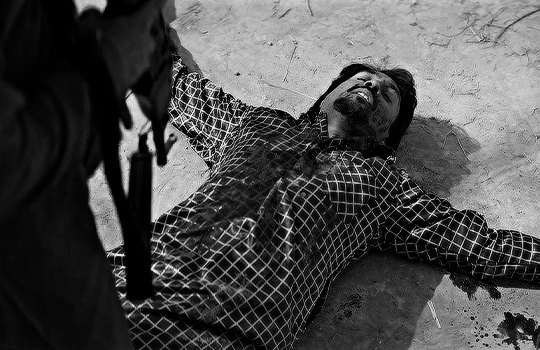
I absolutely loved this film. As many have said before, Amar Singh Chamkila is really a comeback for Ali and shows he’s capable of much more than rom-coms. Returning to directing after four years, Ali does a remarkable job of bringing Chamkila’s story to life without overdramatizing anything, a trait commonly seen in many Indian biographical films. Amar Singh Chamkila feels so authentic in a sense that it feels like I’m living through the story during real time.
I think one reason I felt like that was because of the number of times real footage appeared throughout the film from the time the real Chamkila and Amarjot were alive. I found myself constantly pausing and looking at how accurately Diljit Dosanjh and Parineeti reenacted their real life counterparts based on the pictures and videos included in the film.
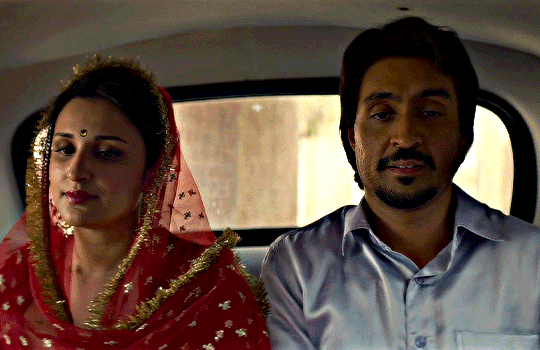
The narrative of the film, starting with the assassination of the couple, captures you from the first shot. Having the story told by people who were involved in Chamkila’s life in some way cements how much of an impact he made around him. I think the only gripe I had with the film was how minimal Gurmail (Chamkila’s first wife) was in the film, but I guess I shouldn’t attribute this to Ali’s’ directing and more to real-life Chamkila marrying Amarjot to keep the partnership alive while still being married to Gurmail. Which is another reason I loved this movie. Ali didn’t completely show Chamkila as a hero. He was, for lack of a better word, morally gray and just wanted to pursue music no matter what.
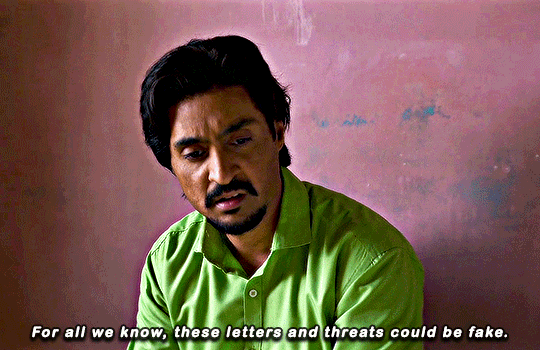
One specific scene that impacted me a lot, though, was when Chamkila and Amarjot are on the funeral pyre and somebody takes pictures of their corpses. The film then interjects that scene with actual pictures of the dead couple taken from the same angle. It hit home for me that this was, in fact, a true story of a man who truly wanted to sing despite all the threats he was receiving. He loved his wife, to the point where his last words were about concern for Amarjot, who had been shot before his eyes (“Babbi, tenu ki hoya?”). But more importantly, Chamkila was a man who revolutionized modern Punjabi music in his short life.
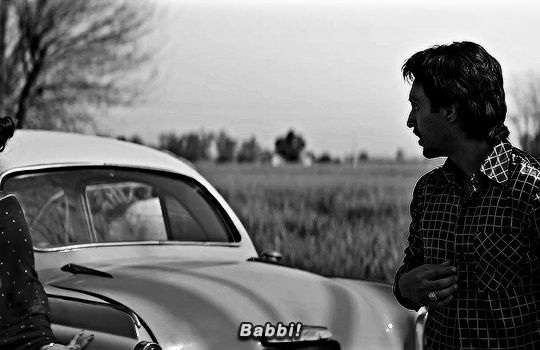
The dialogue, written by Imtiaz Ali and Sajid Ali, stayed true to the Punjabi language. While most of the film was in Hindi, the parts where Diljit and Parineeti were singing Chamkila’s Punjabi songs and it was translated in Hindi on screen was a genius idea to people who may not be familiar with the language. However I did see a lot of discourse about Parineeti not having a lot of dialogue in the film. On further research, though, I found that it was purely in-character for Parineeti not to talk so much, since Amarjot wasn’t a talkative individual anyway.
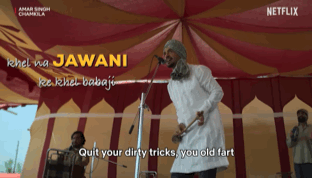
A.R. Rehman, the genius that he is, composed the music for this film. The soundtrack itself was described to be very Broadway-esque, which is the vibe I immediately got, especially with Baaja. The lyrics, by Irshad Kamil, are so poetic (as seen in Vida Karo) and even subtly include double-entendres just like Chamkila without making the songs dirty or cheap (as seen in Naram Kalja). Sidenote: it was so nice to hear Mohit Chauhan’s voice again, especially after not hearing him in many mainstream Bollywood movies anymore.
Also, I would just like to say that Alka Yagnik and Richa Sharma are the highlights of the soundtrack. ARR is possibly the only person who can make Alka sing like that for “Naram Kalja” and I honestly appreciate how fresh she sounds and how the soundtrack in general adapted to our modern times while using traditional instruments in some form. Here’s my list of songs:
Naram Kalja Vida Karo Ishq Mitaye
Also, here’s a Chamkila and Amarjot song I enjoyed that was included in the movie:
Pehle Lalkare Naal

The movie is 146 minutes long (2 hours and 26 minutes). Stream it on Netflix, grab a snack and enjoy!
Do you agree or disagree? Let me know in the comments!
0 notes
Text
Episode 181 - Summer 2023 Media Update
This episode it’s time for our Summer 2023 Media Update! We talk about chairs, orangutans, weird music, and 17 novellas! Plus, lots more!
You can download the podcast directly, find it on Libsyn, or get it through Apple Podcasts, Google Podcasts, or your favourite podcast delivery system.
In this episode
Anna Ferri | Meghan Whyte | Matthew Murray | Jam Edwards
Media & Things we Talked About
Meghan
Graphic Novels
L'Esprit du camp by Cab, Michel Falardo
Friday by Ed Brubaker, Marcos Martín, coloured by Muntsa Vicente
Birds of Maine by Michael DeForge
Looking at Stuff
Saving Time: Discovering a Life Beyond the Clock by Jenny Odell
A Sand County Almanac and Sketches Here and There by Aldo Leopold, Charles W. Schwartz (illustrator)
Outside Lies Magic: Regaining History and Awareness in Everyday Places by John R. Stilgoe
Novellas
Wayward Children by Seanan McGuire
The Singing Hills Cycle by Nghi Vo
Voidwitch Saga by Corey J. White
Matthew
Ducks by Kate Beaton
Weird Music
Venjent - Flowin' with the Vibe
Venjent - Tapping Away
Venjent - Create Machines
Jacek Dzwonowsk - Triple concerto for faucet, water pipes and fiddle
Boys Noize & Pussy Riot - "Chastity" feat. Alice Glass
“Put it in a dick cage”
Yakuza 0 (Wikipedia)
Jam
Captain Disillusion
Orangutan Card Trick DEBUNK
Corridor Crew
VFX Artists React to Bad & Great CGi 57 (Ft. Captain Disillusion)
VFX Artists React to Amazing Movie Props With Adam Savage!
The Girl I Am, Was, and Will Never Be: A Speculative Memoir of Transracial Adoption by Shannon Gibney
Legend of Zelda: Tears of the Kingdom (Wikipedia)
‘Breath of the Wild’ is the Zelda Adventure I've Always Wanted by Austin Walker
Anna
Classy with Jonathan Menjivar
LoadingReadyRun - Swap & Shop - Selling Edition
Kirkland Museum of Fine & Decorative Art
Photos of chairs (on Matthew’s Instagram account)
Cultish: The Language of Fanaticism by Amanda Montell
18 Non-Fiction Military Books by BIPOC Authors
Every month Book Club for Masochists: A Readers’ Advisory Podcasts chooses a genre at random and we read and discuss books from that genre. We also put together book lists for each episode/genre that feature works by BIPOC (Black, Indigenous, & People of Colour) authors. All of the lists can be found here.
Transformed: A Navy SEAL’s Unlikely Journey from the Throne of Africa, to the Streets of the Bronx, to Defying All Odds by Remi Adeleke
A Long Way Gone: Memoirs of a Boy Soldier by Ishmael Beah
Unbecoming: A Memoir of Disobedience by Anuradha Bhagwati
Infinite Hope: A Black Artist's Journey from World War II to Peace by Ashley Bryan
Gabriel Dumont Speaks by Gabriel Dumont, translated by Michael Barnholden
Body Counts: The Vietnam War and Militarized Refugees by Yen Le Espiritu
They Called Us "Lucky": The Life and Afterlife of the Iraq War's Hardest Hit Unit by Ruben Gallego
Knocking Down Barriers: My Fight for Black America by Truman K. Gibson Jr.
Can't Hurt Me: Master Your Mind and Defy the Odds by David Goggins
Ira Hayes: The Akimel O'odham Warrior, World War II, and the Price of Heroism by Tom Holm
Strong Hearts, Wounded Souls: Native American Veterans of the Vietnam War by Tom Holm
Sounding Thunder: The Stories of Francis Pegahmagabow by Brian D. McInnes
The First and Only Memoir By One of the Original Navajo Code Talkers of WWII by Chester Nez
Duty, Honour and Izzat: From Golden Fields to Crimson - Punjab's Brothers in Arms in Flanders by Steven Purewal
Call Me Chef, Dammit!: A Veteran’s Journey from the Rural South to the White House by Andre Rush
The Art of War by Sun Tzu
From the Tundra to the Trenches by Eddy Weetaltuk
Now Let Me Fly: A Portrait of Eugene Bullard by Ronald Wimberly
Give us feedback!
Fill out the form to ask for a recommendation or suggest a genre or title for us to read!
Check out our Tumblr, follow us on Instagram, join our Facebook Group, or send us an email!
Join us again on Tuesday, September 5th when we’ll be discussing the format of Lyric Poetry!
Then on Tuesday, September 19th it’s time for our One Book One Podcast as we discuss the novel Upright Women Wanted by Sarah Gailey!
0 notes
Text
“Ambaraan toh taarein ravaan tod da, teri chunni te sajaun layi // I want to keep plucking stars from the sky, to decorate them on your scarf”
#punjabi music#amrinder gill#goddd amrinder gill is toooo good ugh#💘.txt#this song is so sweet I never paid attention to its lyrics before#love punjab#btw this is a rough translation#Spotify
11 notes
·
View notes
Text
so i recently discovered this song and decided to dissect it's lyrics. so it is about the love story of mirza-sahiban, a folktale native to punjab (usually named alongwith heer-ranjha and sohni-mahiwal).
long story short, mirza and sahiba loved one another deeply and ran away together to marry each other against sahiba's family's wish. mirza decided to rest under a tree even though sahiba begged him to keep moving until they were far enough from her home. but being the mightiest archer around, mirza was arrogant, he knew that no one could touch them or else they'll be k!lled; he went to sleep. but sahiba was worried, because she knew if her brothers attacked mirza, he would kill them. so she broke all of mirza's arrows into half. she thought that she could plead to her brothers to spare him but unfortunately that's not how things panned out.
as soon as her brothers caught sight of mirza, they shot an arrow that pierced his throat. waking up from his slumber, mirza reached for his bow and arrow, only to find it broken. he felt deceived. he looked into sahiba's eyes and begged for an answer as another arrow pierced through his stomach.
aghast at what had happened, she jumped on to mirza's dead body, letting the arrow pierce her as well. As the brothers closed in on them, both mirza and sahiba died a silent death.
therefore, sahiba's name is usually coined with deceitfulness and she is accused of disloyalty.
they lyrics of this song are so specifically tailored for this story, it's beautiful.
(the lyrics are in punjabi, if you don't understand it feel free to google the translation)
12 notes
·
View notes
Text
Punjabi Music, The Power of the Warrior Class
During the course of my childhood and up until now, Punjabi music has always impacted my life, being first-generation South-Asian American, having balanced two cultures, continents and countries my entire life, music is what truly brings me back to connect again with my ancestral roots. India is a vast, big country, and the northern region is extremely different from the Southern region, to the point where people may not even understand each other, if they don't speak that region's language even if they identify as Indian. For the Punjab region in North India, the Punjabi people were the warrior class of 'Hindustan' (India in English) and protected the country for centuries from empires and enemies alike. Wherever the Punjab sword went, order followed. Punjabi music specifically, has a lot of drums, dancing and folk in it. The original name of it is "Shahmukhi '' which translates to Punjabi Folk in English. The music transcends borders and walls, as everyone easily enjoys its loud and upbeat style. In fact, the university I attend; Rutgers University has its own Bhangra Dance Troupe, which is basically the style of dance found in the Punjab region, and they dance to Punjabi music. The specific song, called 'Sadi Gali' in the Bollywood movie 'Tanu Weds Manu' is a modern look to the Punjabi style of music, or songs like 'Kadar' by Mankirt Aulakh, which isn't part of the Bollywood scene, but very relevant to modern Punjabi music, is what young South Asians and anyone for that matter, enjoy and dance too. If you look up 'Bhangra' on YouTube you will find thousands of videos, from people of all races and backgrounds, enjoying Punjabi music. But to deepen its meaning, we must look into artists like, Gurdas Maan, which our grandparents and parents have grown up listening to. In the Punjabi community, his work is both modern and traditional, focusing on the politics happening in the country of India and just music to dance to altogether. His one song, dedicated to 'Bhagat Singh' the legendary freedom fighter, who took on the power of the British and started the Indian Revolution against the British Empire, combines that traditional Punjabi taste of music with modern rap verses in the language Hindi, but in the 'Punjab dialect'. The song focuses on Bhagat Singh's sacrifice and service to the people of India when the colonization took over the country, and completely had Indians fighting against each other, because of the instigation of the British empire, to steal India's natural resource and the country altogether. This song means so much to me and anyone Indian, as it reminds us of what those before us fought for, so that the next generation would have their rights and freedom again. That is why music is so important on all levels for all people, races, colors, genders and orientation. It can be a political impact, a march against evil, a chance to have your voice heard both literally and figuratively. I believe that it is important to learn about the hidden messages in music and the meanings behind the lyrics, as it gives you a chance to broaden one's cultural awareness, intellectual abilities and knowledge of history around the world. Take a look at this article, and please give it a read, it truly talks about the way the British did not appreciate India’s music and vastness of culture, and yet we see happening in our modern times, many White English people in Britain, appropriating the culture and punjabi music. https://www.historydiscussion.net/history-of-india/indian-music-during-british-period/6057 This article gives a clear understanding of just that.
10 notes
·
View notes
Text
Punjab lyrics - Gurjazz | Rana
Punjab lyrics – Gurjazz | Rana
Punjab Lyrics & Song Details: Song Punjab is sung by Gurjazz and written by Rana
Song Title PunjabSinger GurjazzLyrics RanaMusic Sunny Vik Composer Rohanpreet SinghMusic Video Punjab Lyrics
Lyrics Not Available Yet: REQUEST NOW!
~~~~THE END~~~~
If you need Chords or Translation or Karaoke please comment down 🙂
Thank you for reading song “ Punjab Lyrics” sung by Gurjazz till…
View On WordPress
#Punjab karaoke#Punjab lyrics#Punjab lyrics and meaning#Punjab lyrics by gurjazz#Punjab lyrics in chords#Punjab lyrics in hindi#Punjab lyrics songs#Punjab lyrics translation
0 notes
Text
The news of Christ's birth spread across the world (Punjabi Christmas song)
A Christmas Song from Pakistan in indigenous Punjabi folk “Boliyan” genre.
Boliyan or Bolis are couplets that are sung in Punjab. A Boli expresses typical situations and their emotions. Usually a boliis sung and introduced by one woman, and then other girls form a chorus. Men sing boliyan in one region. https://en.wikipedia.org/wiki/Boliyan
My friend Eric, a Pakistani pastor, told me: “The Boliyan genre is a couplet lyrical rhyme with call and response in a group sitting. Boliyan is a thematic genre without any title or chorus. Every couplet conveys a different message with the same theme.
The first couplet in this song translates as: "The news of Christ's birth spread across the world, and the manger is decorated by the presence of baby Jesus"
+++
According to my friend Eric, the composition is in the very popular raga Bhairavi. https://en.wikipedia.org/wiki/Bhairavi_(Hindustani) http://www.tanarang.com/english/bhairavi_eng.htm
This is a production from a Catholic TV station in Pakistan.
+++

‘Moon Face’ painted by M Kazim, Pakistan.
M KAZIM was born in Hyderabad Deccan, India, in 1943- died in Karachi, Pakistan in 2007. He was a distinguished painter, printmaker, calligraphist who worked in mulmul (velvet) cloth and handmade paper and vegetable dyes. Kazim was known for his Indus Valley paintings of Mohen-jo-Daro women as well as Indus Valley reliefs. https://unicorngalleryart.com/products/m-kazim
+++
Punjabi is the mother tongue of more than 120 million people. It is the 10th most widely spoken language in the world. In Canada, it is the fifth most-spoken native language. -- Wikipedia
1 note
·
View note
Video
youtube
Canada, USA and India based Jasmine Sandlas is back with a new album and new videos. “Mood Sarkar Da” finds her shooting at Sealink bridge in Bombay among other spots, with lyrics about feeling at the top of her game and not responding to haters.
Posted by XLE.LIFE’s music curator Hitashya aka Kai Altmann
See lyrics (in Punjabi and roughly translated English)
Hawa Wich Fire Na Kardi Main Gajh Di Sidha Vardi Kise To Main Ki Darna Ho Janta Dare Na Kardi I don’t fire in air I speak directly on the face, why would I be afraid of someone, people don’t dare
Teese Mera Lotted Hai Diggi Wich Rakheya Main Kadh Kadh Photowan Ch Pose Na Maara My weapon is loaded I have placed it in the back hood, getting clicked everywhere I don’t pose
Gaddi Imported Ae Life Meri Sorted Hai Taahi Net Di Nitt Main Fukri Main Maara Car is imported, my life is sorted, that’s why every day on internet I don’t brag out
Gussa Mutiyaar Da Nakk Utte Rehnda Ae Aiven Koi Raah Janda Ajj Ragadeya Na Jaave Girl’s anger Is always on nose Without reason, any pedestrian May not get grinded (face my anger) today (hope that no one face’s my anger without any reason today)
Mood Sarkar Da Landua Naal Khainda Ae Aiven Kujh Keh Ke Koi Jaave Te Kiven Jaave My mood Always fought with the idiots How could someone by saying something Could try to leave
Sirre Di Rakaan Tikhi Ae Zabaan Tahi Sidhi Gall Karne To Darde Ne Top-notch girl Sharp tongue That’s why talking directly They get scared
Roop Di Dukan Kehnde Mehenga Ae Saman Taahi Window Shoppinga Hi Sare Karde Ne Market of beauty, they said that items are expensive, that’s why everyone go for window shopping only
Pyaar Naal Punjab Mainu Gulabi Queen Kehnda Ae With love the entire Punjab Calls me “Gulabi Queen”
Gussa Mutiyaar Da Nakk Utte Rehnda Ae Aiven Koi Raah Janda Ajj Ragadeya Na Jaave Girl’s anger Is always on nose without reason, any pedestrian may not get grinded (face my anger), today
Mood Sarkar Da Landua Naal Khainda Ae Aiven Kujh Keh Ke Koi Jaave Te Kiven Jaave My mood, always fought with the idiots, how could someone by saying something could try to leave
#jasmine sandlas#hitashya music curated#music videos#xle music#punjabi music#new world#hitashyaguestposts#kai altmann#xlelife
1 note
·
View note
Text
Noon Meem Rashed
Nazri Muhammad Rashed (August 1, 1910 – October 9, 1975) commonly known as Noon Meem Rashed or N.M. Rashid, was born as Nazri Muhammad Janjua at Alipur Chattha District Gujranwala formerly Akalgarh, Punjab, Pakistan. He was an influential Pakistani poet of modern Urdu poetry.
Early years
Rashid was born in a Janjua family of Village Kot Bhaaga, Akaal Garh (now Alipur Chatha),[1] Tehsil Wazirabad, District, Gujranwala, Punjab, and earned a Masters degree in economics from the Government College Lahore.[2] He served for a short time in the Royal Indian Army during the Second World War, attaining the rank of Captain. Before Partition, he worked with All-India Radio in New Delhi and Lucknow. Later on, he worked for the United Nations.
Career
Rashed served the UN and worked in many countries. He is considered to be the father of Modernism in Urdu Literature. Along with Faiz Ahmed Faiz, he is one of the great progressive poets in Pakistani literature. His themes run from the struggle against oppression to the relationship between words and meanings, between language and awareness and the creative process that produces poetry and other arts. Though intellectually deep, he is often attacked for his unconventional views and life-style. In an age when Pakistani literature and culture acknowledge their Middle Eastern roots, Rashed highlighted the Persian element in the making of his nation's history and psyche. Rashed edited an anthology of modern Iranian poetry which contained not only his own translations of the selected works but also a detailed introductory essay. He rebelled against the traditional form of 'ghazal' and became the first major exponent of free verse in Urdu Literature. While his first book, Mavra, introduced free verse and is more technically accomplished and lyrical, his main intellectual and political ideals reach maturity in his last two books.
His readership is limited and recent social changes have further hurt his stature and there seems to be a concerted effort to not to promote his poetry. His first book of free verse, Mavra, was published in 1940 and established him as a pioneering figure in free form Urdu poetry.
He retired to England in 1973 and died in a London hospital in 1975. His body was cremated, though no such request appears in his will. This created an outcry in conservative Pakistani circles and he was branded an infidel. Anyhow, he is considered a great figure in progressive Urdu literature.
Poetry
N M Rashed was often attacked for his unconventional views and life style. According to Zia Mohyeddin, a friend of Rashed, "In the time when everybody was in quest of learning English, which was a must for getting some decent job, Rashed was busy in making paintings or poetry."
The themes of Rashed’s poetry run from the struggle against domination to the relationship between words and meanings, between language and awareness and the creative process that produces poetry and other arts.
Initially his poetry appeared to have the influence of John Keats, Robert Browning and Matthew Arnold and he wrote many sonnets on their pattern, but later on he managed to maintain his own style. These were his initial exercises of poetry, which could not last for a longer period of time, and so ultimately he developed and maintained his own style.
He rebelled against the traditional form of the ‘ghazal’ and became the first major exponent of free verse in Urdu Literature. His first book, ‘Mavra’, introduced free verse and is technically accomplished and lyrical.
Family
Rashed's first wife Safia died in 1961 at the age of 46, of an incorrectly administered B-complex injection in Karachi. His second marriage, to Sheila Angelini, took place in 1964.
Rashed had several children. His eldest Nasrin Rashed lives in Islamabad and is retired from her work with the Pakistan Broadcasting Corporation. The second daughter Yasmin Hassan resides in Montreal, and has two children, Ali and Naurooz. His nephew (sister's son) and son-in-law (Yasmin Hassan’s husband) Faruq Hassan was a teacher at Dawson College and McGill University. Faruq Hassan died on November 11, 2011.[3] The third daughter, Shahin Sheikh, now deceased, lived in Washington and worked for the Voice of America. She has two children in the US. Rashed's youngest daughter, Tamzin Rashed Jans, lives in Belgium and has two sons.
His eldest son Shahryar died in 1999 holding the post of Pakistani Ambassador to Uzbekistan. The younger, Nazeil, lives in New York.
Bollywood
His poem "Zindagi sey dartey ho" was set to music in the 2010 Bollywood movie, Peepli Live. It was performed by the Indian music band, Indian Ocean, and received critical appreciation as "hard-hitting" and "a gem of a track" that "everyone is meant to sing, and mean, at some point in life".[4][5]
Bibliography
Mavra
Iran Main Ajnabi
La Musawi Insan
Guman ka Mumkin
#Urdu poetry#Urdu Literature#Urdu#Punjab#Pakistani#Noon Meem Rashed#Gujranwala#England#Alipur Chatha
1 note
·
View note
Text
Sip Sip 2.0 Song Lyrics - Street Dancer 3D

Sip Sip 2.0 Song Lyrics
Sip Sip 2.0 Song Lyrics has taken from Street Dancer 3D and sung by Garry Sandhu, Jasmine Sandlas. Sip Sip 2.0 Song Lyrics has written by Garry Sandhu x Kumaar and music has given by Tanishk Bagchi. This song released by T-Series. Song - Sip Sip 2.0 Song Lyrics Singer - Garry Sandhu, Jasmine Sandlas Music - Tanishk Bagchi Lyrics - Garry Sandhu x Kumaar Label - T-Series
SIP SIP 2.0 SONG LYRICS
Tu Lakh Mtakayi Jaani Ye
Tu Ankh Atkai Jaani Ye
Tu Lakh Mtakayi Jaani Ye
Tu Ankh Atkai Jaani Ye
Cattunt Tu Deke Dil Vale
Blub Nu Jagai Jaani Ye
Badti Javani Meri
Love To Nhi Hot Ve
Khula Kala Nakhra
Takila Da Ye Shot Ve
Or Das Tenu Chahida Ki Ve
Nan De
Nan De
Nan De
Tere Nana De Sarab Di Ya Do Botla
Ena Botla Te Sak Sak Pin De
Nana De Sarab Di Ya Do Botla
Ena Botla Te Sak Sak Pin De
Rab Di Ya Rab Jane
Soni Yaara Di
Pate Da Na Jor Somiya Yaara Di
Hooo
Ugyo Calub Har Vich
Koi Ourhai Ji
Ba Ke Koi Apne Akr Tkaayi Ji
Nan De
Nan De
Nan De
Tere Nana De Sarab Di Ya Do Botla
Ena Botla Te Sak Sak Pin De
Nana De Sarab Di Ya Do Botla
Ena Botla Te Sak Sak Pin De
Nana De Sarab Di Ya Do Botla
Ena Botla Te Sak Sak Pin De
ALSO READ -
Lagdi Lahore Di Lyrics Street Dancer 3D
Punjab Di Ladki Matlab Band Wala Scene LyricsI Am Rider Lyrics Meaning In Hindi Mere Mehboob Qayamat Hogi Lyrics | With Translation |
Pind Lyrics In Hindi - Street Dancer 3D
http://bit.ly/2Uizndo http://bit.ly/2Uizndo from Blogger http://bit.ly/3aYIzJU
0 notes
Text
Daal Dus Khaan Shehar Lahore e Ander
Bai Kinnein Boohey Tay Kinnian Barian Nein?
Of the city of Lahore, O’ let me know
How many windows and how many doors?
Naley Das Khaan Aothon Dian Ittaan
Kinnian Tuttian Tay Kinnian Saaran Nein?
Also tell me of the bricks’ state
How many lie intact and how many still disintegrate?
Daal Dus Khaan Shehr Lahore e Andar?
Khooian Kinnian Mithian Tey Kinnian Khaarian Nein?
Tell me, in Lahore, the number of salty wells
And also the number in which sweetness dwells?
Zara Soch Key Dewien Jawaab Meinoon
Aothey Kinnian Viyaeyan Tay Kinnian Kunvarian Nein?
Ponder hard, and return with my answer embedded
How many women are betrothed and how many still unwedded?
Daal Dassaan Mein Shehr Lahore e Ander
Bai Lakhaan Boohey Tay Lakhaan e Baarian Nein
Let me tell you now, in the city of Lahore
There are thousands of windows and thousands of doors
Jinnaan Ittaan Tay Tahar Gaey Paer Aashiq
O Heoon Tuttian Tay Baqi Saarian Nein
Bricks that felt the Lover’s footstep lay all broken
Others that did not lay intact, unawoken
Jinnaan Khooian Toun Paher Gaey Mashooq Paarrein
O Heon Mithi Te Baaki Khaariya Nein
Those wells alone that Lovers touched bore sweetness so divine
And those that shared not a similar fate remained ever saline
Daal Dus Khaan Shehr Lahore e Andar?
Khooian Kinnian Mithian Tey Kinnian Khaarian Nein?
Those seated alongside their lovers alone are truly married
And those with a destiny alternate have solitary tarried
https://soundcloud.app.goo.gl/NYY99ZcT9FJ9sAjV7
#punjabi#punjab#lahore#hadiqa#love songs#song lyrics#translation#poetic#beautiful#beauty#divine#heavenly#gorgeous#magical#maginificent#windows#doorsoftheworld#life#love#inspirationalwords#blissful#poem#positivity#books#poetry#sweet words#beautiful words#words#inspirational words#wise words
7 notes
·
View notes
Photo

Translate of Hardy Sandhu's (Backbone) 💙 First attempt at translating a Asian song in English, I think I did a decent job lol 💙💙💙💙💙💙 #hardysandhu #backbone #jaani #britasia #lyrics #mylyrics #mythoughtzmywordz #ohnoshedidntt #writer #writers #writerlife #writerslife #writersofig #writersofinstagram #writerscommunity #instagood #instagram #song #singer #soch #firstattempt #translate #india #punjab #worldwide #actor #loved #poem #rap #love
#worldwide#writersofig#instagram#writerlife#lyrics#translate#instagood#mythoughtzmywordz#hardysandhu#jaani#writer#mylyrics#india#soch#firstattempt#rap#writers#writersofinstagram#actor#poem#love#writerscommunity#backbone#writerslife#punjab#britasia#song#ohnoshedidntt#loved#singer
1 note
·
View note
Text
Bhagavathi Songs Download Naa Tracks, Ideal MP3 Download And Install Free
mp3 download Bhagavathi Songs Download Naa Tracks totally free pagalworld for pc emergency room online djpunjab mr jatt 320kbps arijit singh application arijit singh tracks apk application download android a na milo humse zyada bollywood tunes bhajan internet browser bahubali 2 b converter firm cutter chain rip off codes clip converter downloader despacito download dj i wish to download home windows 7 download music website share mp3 documents free mp3 songs download websites tom ftp download mp3 sites download and install speed pay attention to songs
Bhagavathi Songs Download Naa Tunes – below
mp3 download master punjabi g online songs top us web sites finest company sites best page best online best new web sites best logo designs topgreat inc ideal internet sites 2016 the most effective us financial debt message to give away church donation on the internet donation download sheet kannada tracks katy perry krishna kirik party kuch hota hai k downloadomola sunduri link latest checklist most current tracks latest punjabi tunes latest english l in mp3 supervisor movies mp4 mp3 pagalworld new brand-new songs naa tracks new punjabi tunes brand-new flicks brand-new tracks 2017 n online on youtube old tracks
mp3 download Bhagavathi Songs Download Naa Tracks old one instructions org pagalworld 2017 portal punjabi pk player p quran qawwali tune kismat by ammy virk qwali nusrat fateh ali quran with urdu translation q mp4 download r raagtune ringtone raabta movie ringtone download superstar r feet justin tracks track download starmusiq software website track mp3 s d sphadikam gush tamil telugu tubemate tamil tunes telugu tracks t download rajinikanth upkar udit narayan udta punjab classy funk udi jaye u video clip video download vidmate video song vidya vox viva home windows 10 windows phone web site wap work wapking w x 21 savage youtube video clips youtube app youtube songs youtube mp3 youtube converter y zip 2017 complimentary download click to start download tax deductible contributions contribute my car to charity contribute your auto lorry donation contribute automobile to charity ways to contribute a vehicle auto contribution tax obligation deduction a good reputation vehicle donation charitable companies give away publications online offering charity gifts boat donation charitable donations music downloader online
Download Free Mp3 Bhagavathi Songs Download Naa Tunes Every one of video/mp3 that appear on this comemp3.com website were found from web. The Web designer does not hold any type of Legal Civil liberty of Possession on them. We don’t save/host this Bhagavathi Tracks Download and install Naa Tunes video/mp3 in our holding. If by anyhow any one of them stinks to you, please Call United States requesting for the removal.Mandaara Complete Video Song 4K |
Bhaagamathie Film|hka|Shreya Ghoshal|Thaman S|2018 Tracks
Bhaagamathie Signature Tune|The Audio of Bhaagamathie|hka Shetty|Unni Mukundan|Thaman S
Bhaagamathie Telugu Movie Songs|Mandaara Complete Track with Verses|hka|Unni Mukundan|Thaman
Mandaara Video Clip Track|Bhaagamathie Telugu Motion Picture Songs|hka Shetty|Unni Mukundan|Thaman S
Mandhaara Complete Tune with Lyrics|Bhaagamathie Malayalam Film Tunes|hka|Unni Mukundan
Naa Madhi Swarnalayam – Ayyappa Swamy
Mandaara Video Tune|Bhaagamathie Telugu Motion Picture Songs|hka Shetty|Unni Mukundan|Thaman S
Gulaebaghavali|Guleba Full Video Song|4K|Kalyaan|Prabhu Deva, Hansika|Vivek Mervin
ദേവീഗീത|Devi Geetham|K.S.Chithra|Hindu Devotional Songs Malayalam|Devi Songs
from hundred watt studio http://www.hundredwattstudio.com/bhagavathi-songs-download-naa-tracks-ideal-mp3-download-and-install-free/
0 notes
Text
Real Punjab lyrics - NseeB
Real Punjab lyrics – NseeB
Real Punjab Lyrics & Song Details: punjabi Song Real Punjab is sung by NseeB music is given by Vitamin & Jagga.
Song TitleReal PunjabSingerNseeBMusicVitamin & JaggaArtist NseeB and Gurkarn Chahal Music Video Real Punjab Lyrics
Mein os thaa’n ton jithe behende panj aab Hoyi’aa maut na majakan nappe chidiyaan ton baa…
View On WordPress
#NseeB#Real Punjab lyrics#Real Punjab lyrics and chords#Real Punjab lyrics and meaning#Real Punjab lyrics by NseeB#Real Punjab lyrics in hindi#Real Punjab lyrics in punjabi#Real Punjab lyrics songs#Real Punjab lyrics translation
0 notes
Text
Meri Manzil tu masiha/My destination is Christ (Pakistan)
Arif Bhatti is a popular composer and singer in Pakistan. In this video he sings a song on a TV show hosted by the Agape Sisters.
NAKAASH JOUHAR plys a harmonium. The song title translates as “My Destination is Masiha [Messiah/Christ].”
A summary of the lyrics: “Jesus, you are the way, my ultimate companion, and my destination.”
Watch the video at https://youtu.be/CYBGIJ00lGQ
+++
Arif Bhatti is the Director of a YWAM School of Worship in the Punjab region of Pakistan. https://www.facebook.com/SOW-School-of-Worship-Pakistan-113060538854482/ https://www.facebook.com/arif.rogers

0 notes